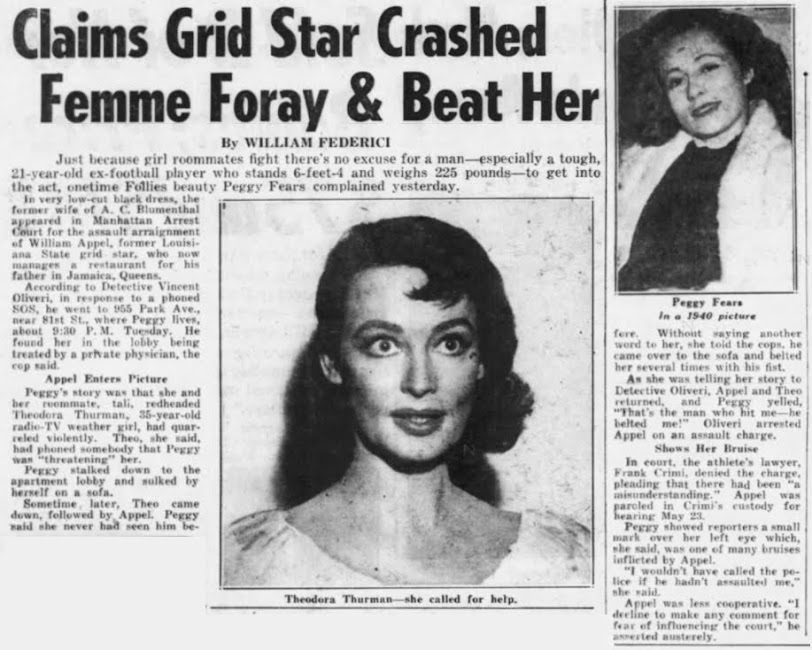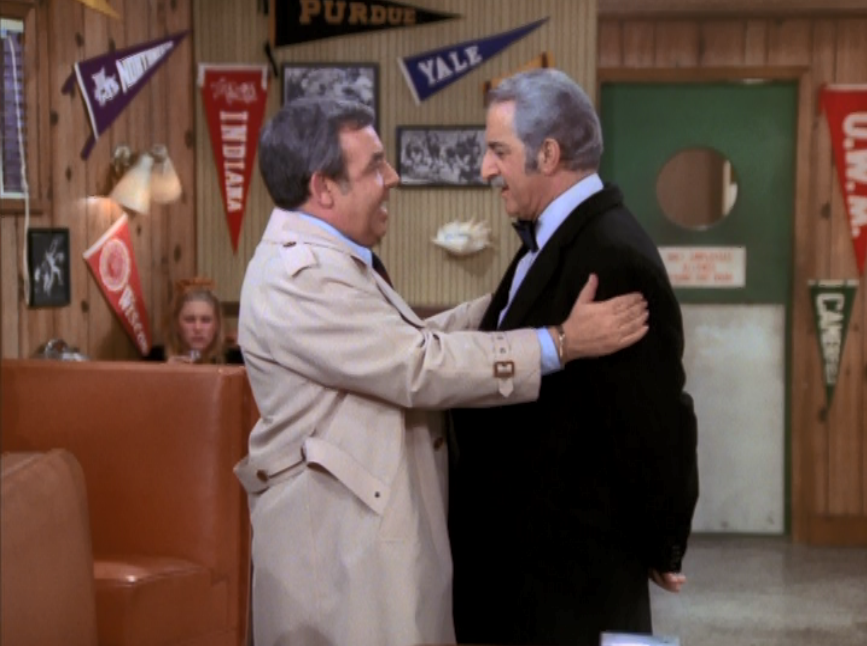 |
| Theodora "Tedi" Thurman during her days as Monitor's weather girl. |
Of all the performers to work with Ed Wood during his 1950s heyday, few are more intriguing than Theodora "Tedi" Thurman (1923-2012). She appears in just one of Eddie's movies, playing sultry gun moll Loretta opposite Timothy Farrell's grouchy gangster Vic Brady in 1954's Jail Bait. This eye-catching supporting role was Tedi's lone feature film credit, but it's not her only claim to fame by any means. A striking beauty from Georgia, Tedi Thurman worked as a model and radio personality, gaining acclaim for her husky voice and statuesque looks.
In Rudolph Grey's 1992 book Nightmare of Ecstasy, Thurman remembered Ed Wood as "a very nice, gentle person" and says that she turned down a movie offer from Columbia Pictures in order to model for Vogue in Europe. Ultimately, she decided to forego a film career altogether because she'd heard horror stories about Hollywood. Timothy Farrrell, for one, was quite impressed by Thurman, describing her as "a hell of a good actress" to Grey. Farrell also reported that Thurman attracted lots of attention on the Jail Bait set, which is understandable.
This Jail Bait ad from the April 12, 1955 edition of The Fort Worth Star-Telegram prominently lists Theodora Thurman alongside Dolores Fuller, Lyle Talbot, and Steve Reeves. Interestingly, the ad copy implies that the girls in the film are the titular jail bait, while in the context of the script, that term refers to guns. Note, too, that the woman pictured in the ad is Mona McKinnon instead of Fuller or Thurman.
 |
| A 1955 newspaper ad for Jail Bait. |
After her brief but memorable experience with Ed Wood, Thurman gained nationwide popularity by delivering sultry, flirtatious weather reports on the radio show Monitor from 1955 to 1961. On that acclaimed series, she was known as "Miss Monitor" and temporarily shared a recording booth with the beloved comedy team of Bob Elliott and Ray Goulding. In the 2013 book Bob and Ray: Keener Than Most Persons by David Pollock, Thurman is described as "five-foot-seven, with cascading red hair." Elliott remembered that she had "a pleasant, slightly offbeat personality" and would sometimes bring in homemade hush puppies. The book also pointed out that Thurman pronounced the word "temperature" as "temper-toor" and was "an instant hit" with listeners. Her popularity extended to The Tonight Show, where she made several on-camera appearances during Jack Paar's troubled reign.
This October 11, 1957 article from The Boston Globe ruminates on Thurman's unusual fame.
 |
| Tedi Thurman was making $60,000 doing the weather in 1957. |
Tedi Thurman never married, but the 1971 book Whatever Became Of... Third Series by Richard Lamparski states that "Miss Monitor" had "a stormy longtime relationship" with an older woman named Peggy Fears, who had performed in the Ziegfeld Follies in her youth and had eventually become a Broadway producer. Thurman fondly discussed her relationship with Fears in When Ocean Meets Sky, a 2003 documentary about the gay community at New York's Fire Island Pines.
Thurman and Fears had their share of difficult times, however, some of which wound up being reported by the press. The May 12, 1960 edition of New York's Daily News carried an article on page 4 about a violent argument between the lesbian lovers. Apparently in need of backup, Thurman called former college football player William Appel to the Park Ave. apartment she shared with Fears, and Appel ended up catching an assault charge from Fears. Notice how Theodora Thurman is euphemistically described as "a friend of Peggy's."
 |
| A domestic quarrel becomes a full-on brawl. |
The Thurman/Fears clash must have been a major event in New York, because there was a longer, more elaborate story about it on page 32 of that same edition of the Daily News, this time with a byline by William Federici. In this article, Fears and Thurman are described as "girl roommates." The tone here is considerably more gossipy.
 |
| More information on the Fears/Thurman bout of 1960. |
This was certainly an unusual and distressing episode in the memorable life of Theodora "Tedi" Thurman, probably one she wouldn't have wanted splashed across the pages of a newspaper. And the duo's wild days were far from over. The September 1, 1963 issue of The Fresno Bee reported that Thurman and Fears were arrested for drunk, disorderly conduct alongside openly gay comedienne Patsy Kelly, who first found fame in the 1930s as a sidekick to Thelma Todd.
 |
| Tedi and Peggy were arrested in 1963, alongside Patsy Kelly. |
...
Before we leave our little scrapbook about Ms. Thurman, here's another item from the Daily News, this time the December 26, 1949 edition. Here, the "Manhattan fashion model" gives her thoughts on the wolfishness of married men.
 |
| Theodora gives her opinion on men. |












